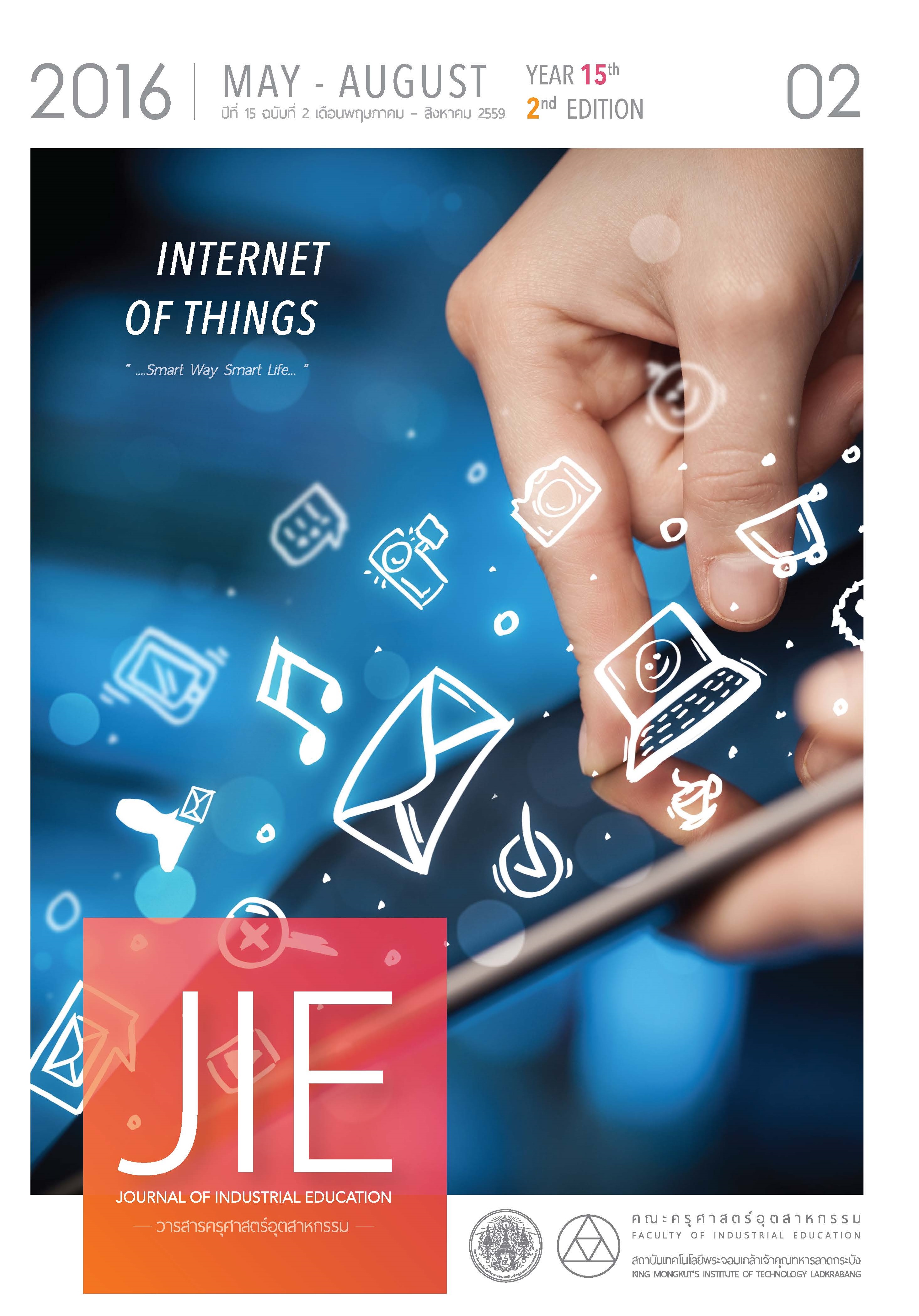A DEVELOPMENT OF BLENDED LEARNING WITH THE INTEGRATION OF WEB-BASE INSTRUCTION VIA CLOUD COMPUTING ON BENCH WORK AND THE ELECTRONIC CIRCUITS OF UNDERGRADUATE STUDENTS
Main Article Content
Abstract
The purposes of this study were to develop and evaluate the quality as well as the efficiency of blended learning with the integration of web-based instruction via cloud computing on bench work and the electronic circuits; to compare pre-test and post-test learning achievement of the students after the experiment. The samples in this study, which were divided into two groups: a group of 30 freshmen studying at The Faculty of Engineering, KMITL, in the academic year 2557, used for testing the efficiency of the instrument and the other group of 30 freshmen studying at The Faculty of Engineering, KMITL, used for comparing learning achievement after the experiment, were obtained by means of Cluster Sampling. The research instruments were blended learning classroom with the integration of web-based instruction via cloud computing, the evaluative questionnaire, and the achievement test. The consistency index (IOC) was reported between 0.67-1.00 while the level of difficulty (P) was between 0.40 - 0.80; the discrimination (R) was between 0.20 - 0.70 while the test reliability (KR 20) was at 0.79. The statistics used in the analysis were mean (), standard deviation (S), and t-test for Dependent Samples.
The result showed that the quality of blended learning with the integration of web-based instruction via cloud computing was at a very good level (= 4.55, S = 0.49) and the quality in media production was at a good level (
= 4.67, S = 0.46). It is also found that the efficiency of web-based instruction lessons (E1/E2) was 84.17/83.67 respectively, all of which was based on the assumption that it should not be less than80/80 and when compared to the overall learning achievement. It was also revealed that post-test achievement score was higher than that of the pre-test at 0.05 significant level.
Article Details
"The opinions and contents including the words in papers are responsibility by the authors."
"ข้อคิดเห็น เนื้อหา รวมทั้งการใช้ภาษาในบทความถือเป็นความรับผิดชอบของผู้เขียน"
References
[2] ประเทือง วิบูลศักดิ์. 2553. การเรียนรู้แบบผสมผสาน และ การสอนแบบผสม คืออะไร. [ออนไลน์]. เข้าถึงได้จาก: https://www.sahavicha.com/?name=blog&file=readblog&id=5720 (วันที่ค้นข้อมูล: 4 เมษายน 2559)
[3] ปิยวรรณ์ สกุลพิชัยรัตน์. 2557. เรียนรู้และเข้าใจก่อนเข้าสู่โลกของ Cloud computing กระทรวงการคลัง. สำนักงานเลขานุการกรม สถาบันพัฒนาบุคลากรด้านการคลังและบัญชีภาครัฐร่วมกับกระทรวงการคลัง.
[4] ถนอมพร เลาหจรัสแสง. 2544. การสอนบนเว็บ-นวัตกรรมเพื่อคุณภาพการเรียนการสอน. วารสารศึกษาศาสตร์, 28(1), น. 87-94.
[5] มนต์ชัย เทียนทอง. 2548. การออกแบบและพัฒนาคอร์สแวร์สำหรับบทเรียนคอมพิวเตอร์. กรุงเทพฯ : ภาควิชาคอมพิวเตอร์ศึกษาศาสตร์ คณะครุศาสตร์อุตสาหกรรม สถาบันเทคโนโลยีพระจอมเกล้าพระนครเหนือ.
[6] Jared M. Carman. 2005. Blended learning design: Five key ingredients. [ออนไลน์]. เข้าถึงได้จาก: www.agilantlearning.com/pdf/Blended Learning Design.pdf(วันที่ค้นข้อมูล: 4 เมษายน 2559)
[7] ไฟโรจน์ ตีรณธนากุล และคณะ. 2546. การออกแบบและผลิตบทเรียนคอมพิวเตอร์การสอนสำหรับ E-learning. กรุงเทพฯ : ศูนย์ส่งเสริมกรุงเทพฯ.
[8] ชัยยงค์ พรหมวงศ์. 2542. ระบบสื่อการสอน. กรุงเทพฯ: โรงพิมพ์จุฬาลงกรณ์มหาวิทยาลัย.
[9] Anderson, L W, & Krathwohl D R. 2001. A Taxonomy for learning, Teaching, and Assessing: A Revision of Bloom’s Taxonomy of Educational Objectives. New York: Longman.
[10] สรรรัชต์ ห่อไพศาล. 2544. นวัตกรรมและการประยุกต์ใช้เทคโนโลยีการศึกษาในสหัสวรรษใหม่: กรณีการจัดการเรียนการสอนผ่านเว็บ. วารสารศรีปทุมปริทัศน์, 1(2), น. 93-104.
[11] นุชนาถ อินทรวิจิตร. 2557. การพัฒนาบทเรียนบนเครือข่ายอินเทอร์เน็ตเพื่อทบทวน เรื่อง ตัวแปรและตัวดำเนินการในการเขียนโปรแกรมด้วยภาษาซีชาร์ป (C#). หลักสูตรวิทยาศาสตรมหาบัณฑิต คณะครุศาสตร์อุตสาหกรรม สถาบันเทคโนโลยีพระจอมเกล้าเจ้าคุณทหารลาดกระบัง.
[12] เมธี คชาไพร. 2558. การพัฒนารูปแบบการเรียนการสอนแบบผสมผสานเพื่อเสริมสร้างความรู้และสมรรถนะด้านนวัตกรรมและเทคโนโลยีสารสนเทศทางการศึกษา สำหรับนิสิตหลักสูตรการศึกษา บัณฑิตมหาวิทยาลัยศรีนครินทรวิโรฒ. วารสารวิชาการและวิจัยสังคมศาสตร์, 29(1), น. 71-86.
[13] ปรัชญานันท์ นิลสุข. 2555. เทคโนโลยีสารสนเทศทางการศึกษา. กรงเทพฯ. ศูนย์ผลิตตำราเรียน. มหาวิทยาลัยเทคโนโลยีพระจอมเกล้าพระนครเหนือ.
[14] อริยา คูหา และบัญญัติ ยงย่วน. 2547. ปัจจัยที่ส่งผลต่อผลสัมฤทธิ์ทางการเรียนในภาวะรอพินิจของนักศึกษามหาวิทยาลัยสงขลานครินทร์ วิทยาเขตปัตตานี. วารสารสงขลานครินทร์, ฉบับสังคมศาสตร์และมนุษยศาสตร์, 10(3), น. 255-271.
[15] นภดล จักรแก้ว. 2556. การพัฒนาบทเรียนผ่านเครือข่ายอินเทอร์เน็ตเพื่อทบทวน เรื่อง ภาษาซี วิชา การเขียนโปรแกรมเชิงโครงสร้าง. วารสารครุศาสตร์อุตสาหกรรม, 12(2), น. 32-37.
Noppadon Chukkaew, N. 2013. Development of Web – Based Online Instruction For Review On C Language For Structure Programming. Journal of Industrial Education, 12(2), p. 32-37.

